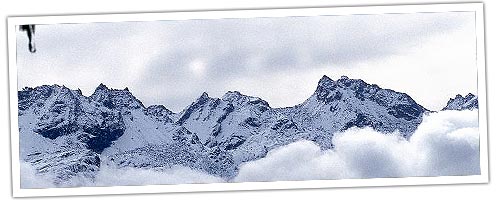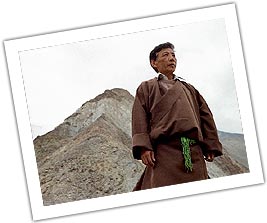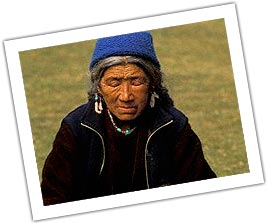Rajasthan Tour Package
» Royal Rajasthan Tour» Rajasthan India Tour
» Trip to Rajasthan
» Vacation In Rajasthan
» Rajasthan Tour Travel
more...
|
Ladakh Pilgrimage & Cultural Tour Operator- offering
Ladakh tours, ladakh tour packages, cultural tours in ladakh,leh ladakh
tours, tour to leh ladakh, leh ladakh travel, travel to ladakh, ladakh
travel, ladakh cultural tours, cultural tour packages, ladakh pilgrimage
tours, pilgrimage tours ladakh.
|


ARTICLESK DANCES AT HEMIS FESTIVAL Text by Phuntsog Dorjay (Pelik)Research
Scholar, Jammu University.
The mask dances of Ladakh are referred collectively as Chams Performance.
These Dances are an essential part of Tantric Vajrayana tradition. They
constitute an indispensable part of monastic and religious life of the people
of Ladakh. The origin of the Cham dances goes back to the year A.D. 811
when the Guru Padmasambhava1 performed the Black-Hat Tantric dance to banish
evil spirits who were an obstacle to building the Samey monastery in south
east of Lhasa. Chams are performed in Gonpas where the monks follow the
Tantric Vajrayana teachings. Chams are performed with masks, and the costumes
of various medititve and protective deities with solemn movements of legs
and hands to the special music of drums, cymbals and wind-instruments. While
there can be any number of meanings given to dance, it is in the hidden
codes of gestures and postures that one may look for a constructive interpretation.
The Hemis monastery, foremost of the three bDruk-pa monasteries, founded
by Senge Namgial, traces its intellectual lineage to the bKa-rgyud-pa sect
or the "Followers of Transmitted Command", of Tibetan Buddhism
founded by Marpa (1012). Their authoritative texts are the Mahayoga Tantras
which expound the teaching of the esoteric inner Tantras as opposed to the
exoteric ones. These works have a different flavour from the sutra texts
of early Buddhism. Buddhist works after the 11th Century are known as the
new tradition. The Vajrayana expounded a tradition of Empowerment, wherein
the goal of enlightenment is reached in a short period of time. In the inner
esoteric Tantra, Sadhanas expound the experience of oneness through simultaneous
awareness of the true nature of the body, speech and mind. The practices
at the Hemis Monastery are a direct lineal descent of the teachings expound
in the Mahayoga Tantra School, or the esoteric school of Vajrayana.
It is said that during 1191-1274, the great sage rGod-tsangpa mGonpo rDor
-je came to Ladakh and meditated several years in the upper part of Hemis
gorge in a cave which later became famous as rGod-tsang. According to the
Tibetan calendar, the great annual festivals held in the villages of Ladakh
all takes place in winter, with the exception of Tseshu held at Hemis in
summer. This is one of the most important events of the valley. From the
time of Rgyalsras Rinponche around the year 1730, the Hemis Festival has
been observed year after year without break and has now become well known
the world over.
It is believed that guru Padmasambhava descends as a representative incarnate
of all the Buddhas, to bestow grace and improve the condition of the living.
He does so on the tenth day of each month and all the ten days which comes
in a year or the most important of the tenth of the Monkey year in a cycle
where the Thanka of guru is exhibited, locally call Naro-gyantuk or "the
Pilgrimage". It is believed that Padmasambhava lives in bodiless form
and returns each year to Ladakh to liberate the people. This Thanka of guru
Padmasambhava is a marvelous painting, a patched work of silk cloth of various
colour and was prepared around 1750-1760 by Zopa Pale on advice of rGyalras
Mipham Tsewang. This Thanka is exhibited once on the 10th day of 5th month
in the monkey year in a cycle of 12 years. The purpose of sacred performance
and the dances is to bestow good health, subjugate disease and conquer evil
spirits. The festival commemorates the birthday of the guru Padmasambhava,
the celebrated founder of the Lama tradition and the presiding authority
of Tibetan Buddhism.
It is said that three incarnation of Zambalha, the god of wealth gathered
at Hemis. They are the head lama H.H. Rgyalras Mipham Tsewang, the manager
(Chagzot) Tashi and artist and craft master Zopa Pale. These three jewels
contributed their whole assets for the development of Hemis monastery DAY
FIRST:On the first day of the festival, while the music is being played,
thanka of guru Padmasambhava, nearly four storeys in height made of patched
work silk is hung against the facade of the monastery. This is exhibited
once in the Monkey year in a cycle of 12th year and rest of the year they
exhibit the thanka with a portrait of Gyalsras Rinpoche, the initiator and
founder of the monastery. Around 9.40 A.M. two adolescent monks blow conch-shells
from the roof top of Gonpa. The sound of the conch, blowing from the roof
of the Hemis monastery represents the voice of dharma. This is the first
call for the monks and the visitors to get ready. The second call is to
march to the Gonpa and the third, to gather in the assembly hall for Morning
Prayer before starting the dance. A number of play welcome music in the
courtyard.
 The
music at Hemis consisted of chanting and recitation of texts and
instrumental music played by the monk musician. The entire orchestra at
Hemis consisted of many instruments (some in pairs)
The
music at Hemis consisted of chanting and recitation of texts and
instrumental music played by the monk musician. The entire orchestra at
Hemis consisted of many instruments (some in pairs) | Name | Color of Masks | Attributes in Hand |
| 1 | Yab (male) | Red Spear and heart |
| 2 | Yum (female) | Black-brown Tishud and heart |
| 3 | Vajrasattva | Black Flag and hammer |
| 4 | Yama Brown | Noose and chain |
| 5 | Naga Demon | Black Snake rope |
| 6 | Demon Black | Sword and rope |
| 7 | Titan Red | Rope |
| 8 | Srinpo gaint | Blue-black Stick and iron hook |
| 9 | Brahma White | Knife and arrow |
| 10 | Marti-kali | Brown Sword and bag of diseases |
| 11-12 | Monkeys | |
 THE
DANCE OF THE DHARMA GUARDING DEITIES(Dance of Maha Dongchen)Afternoon
session began with the dance of Maha Dongchen with a buffalo faced mask and
his entourage of the following masked figures: four Black-Hat Tantric
dancer; four dancers with metal masks; four Pumets with masks with gaping
mouths; four dancer with monks, robes with benign masked faced with staff
and bowl in hand; four Pisky-faced dancers, unmasked with painted faces;
four figures wearing grotesque and ferocious brown, white, red and green
masks. They together formed the helpers and gate guards of Dongchen. Their
task is to put end to evil forces. They come in and dance together
encircling the flag-staff. While the dancers perform their dance, two monks
inscribe a triangle- mandala in blue with white and red outline. Another
lama walk in with a plate with sacrificial effigy made of dough concealed
with a veil. The dish will place in the centre of the mandals on which a
mantra is also inscribed. Two lamas enter, one with a plate with ritual
chalices and other with the samovar. They stood by the mandals. Then
Black-Hat dancers enter along with them and stood around the mandala.
THE
DANCE OF THE DHARMA GUARDING DEITIES(Dance of Maha Dongchen)Afternoon
session began with the dance of Maha Dongchen with a buffalo faced mask and
his entourage of the following masked figures: four Black-Hat Tantric
dancer; four dancers with metal masks; four Pumets with masks with gaping
mouths; four dancer with monks, robes with benign masked faced with staff
and bowl in hand; four Pisky-faced dancers, unmasked with painted faces;
four figures wearing grotesque and ferocious brown, white, red and green
masks. They together formed the helpers and gate guards of Dongchen. Their
task is to put end to evil forces. They come in and dance together
encircling the flag-staff. While the dancers perform their dance, two monks
inscribe a triangle- mandala in blue with white and red outline. Another
lama walk in with a plate with sacrificial effigy made of dough concealed
with a veil. The dish will place in the centre of the mandals on which a
mantra is also inscribed. Two lamas enter, one with a plate with ritual
chalices and other with the samovar. They stood by the mandals. Then
Black-Hat dancers enter along with them and stood around the mandala. 
| Make My Trip | Hotel Booking | Car/Coach Rentals | Indian Tour Packages | Lodges & Resorts |
| Holidays in India | India Holiday Packages | |||
| India Travel Destinations | Rajasthan Tourist Places | Tourism in India | Trekking in India | Wildlife in India |
| Home |
Sitemap | About
Us | Contact Us |
Travel Web Directory
Travel
Resources Copyright © Spectrum Tour |